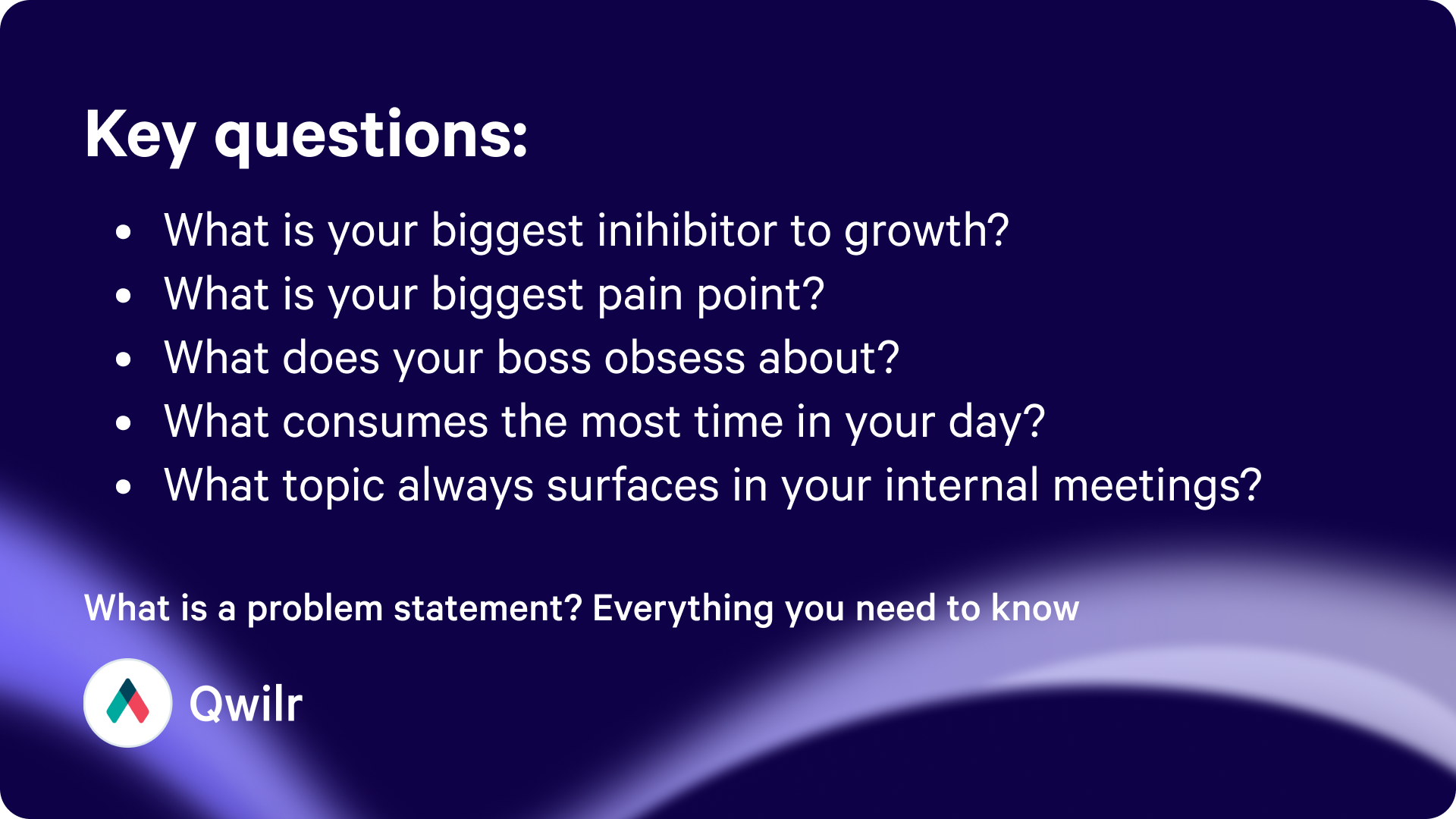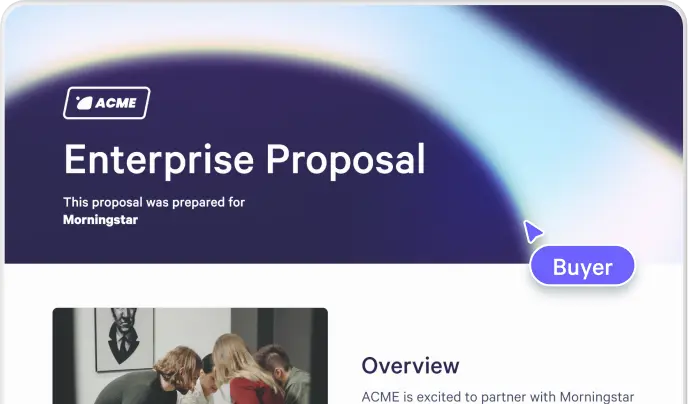
Starting with a good problem statement can set the stage for finding the best solutions, closing more deals, and delivering better services for your clients. This is why writing an effective problem statement is crucial to making sure that the issue at hand is clearly defined and understood by everyone involved — your team members and your customers alike.
How to write a problem statement that enhances the power of your sales proposal and makes your solution attractive to all your prospect’s stakeholders?
What is a problem statement?
A problem statement is a clear and concise description of the problem or issue that your client is facing. It covers a brief situational assessment, the desired result, and the gap between them.
A well-written problem statement should accurately reflect your client's pain points and needs and highlight why it is important for them to address this issue.
Your problem proposal is not the only element of a successful sales or marketing proposal. But it can set a solid foundation for your solution by providing direction and context.
Looking to generally level up your proposal writing skills? Our ultimate guide to creating better proposals provides a comprehensive overview of the language, content, design, and even the technology to improve your proposals.
Why is writing a problem statement important?
An effective problem statement can set the tone for a fruitful work relationship.
Think of it this way: many organizations feel compelled to show their clients all their creative solutions. But in that process, they neglect their client’s problem and fail to understand the underlying challenge.
When there is a misalignment between your solution and your client’s problem, your client becomes skeptical and begins questioning whether or not you are the right fit for them. In other words, your lack of understanding widens the relevancy gap between your product or service and the problem your prospect came to you to solve.
Writing problem statements is important because it:
Clarifies the expectations
If there's a surefire way to start a client relationship on the wrong foot, that's having conflicting understandings of the project.
A well-written problem statement ensures that everyone involved in the project clearly understands what needs to be solved and why. This eliminates any potential for scope creep, reduces miscommunication, and builds trust between you and your client.
Guides the focus on the solution
It is a thousand times better to stay laser-focused on the solution your customer needs than to spread too thin and try to cross-sell them into adjacent services before you've shown the results of your work.
And results are always quicker (and more scalable) to achieve when you have a clear direction rather than when you're aimlessly throwing darts at the board.
An effective problem statement serves as a guiding light throughout the sometimes meandering, maze-like process of finding a possible solution. With a clear problem statement, your team can stay focused on addressing the specific issue at hand and avoid unnecessary distractions.
Helps align your ‘why’
Your problem statement goes beyond the sales process per se — it dives deep into how you serve your clients.
Completing a project successfully requires staying on track, especially when unexpected challenges arise. A well-written problem statement can be a constant reminder of the original goal and keep your team on the same page throughout the project.
Think of it as the why behind your project's goals. If you were to proceed on a weight loss journey today, your why behind going to the gym would be, “I want to lose 20 pounds and maintain a healthy lifestyle.”
Similarly, your problem statement should be clear and concise with its purpose. It's not about "going to the gym" but rather focusing on the desired outcome.
Strengthens the client relationship
Taking a macro approach illustrates the big picture of your prospect's problem and the challenges your client is facing. Additionally, it shows your prospect you are listening— a big step in creating a personalized buyer experience.
When you summarize the problem, there are two positive outcomes.
- You either reaffirm that you understand the problem so you can now appropriately customize your solutions. Tailoring your offering goes a long way in forming trust between you and your potential client.
- You realize you need more information. If you're writing your problem statement and realize that you don't understand the issue thoroughly, ask your client for clarity to get everyone aligned. Your willingness to work together to dig deeper into the root cause of the problem builds trust and transparency, which are key to any long-term client relationship.
Both outcomes are a win and only strengthen the relationship with your potential client. A word of caution: never try to bluff your way through a problem statement— your prospect will pick up on your lack of understanding and look to another solution provider who has a greater grasp of their needs.
Helps you stand out from other proposals
No matter your industry, your sales proposal will likely compete against other companies for your potential client's business. A well-written problem statement can make all the difference.
By clearly and accurately articulating the issue at hand, you are not only demonstrating your expertise and understanding of the problem but also differentiating yourself from other proposals that may not be as thorough or relevant.
How to write an effective problem statement
Writing an effective statement of the problem is not rocket science — but it does require an analytical, structured approach to ensure you capture all the necessary details in a compelling way.
Here are some elements of a problem statement to help you get started:
Understand your client's business
Writing a problem statement allows you to break down the issues for your target audience in a holistic summary. Of course, before summarizing your client’s problem, you must truly understand it first. This involves an open dialogue about the specific bottlenecks and challenges your client faces.
You might ask your prospect questions like:
- What is your biggest inhibitor to growth?
- What is your biggest pain point?
- What does your boss obsess about?
- What consumes the most time in your day?
- What topic always surfaces in your internal meetings?

Contextualize the problem
Once you've pinpointed your client's precise challenge, you need to place it in a broader context. By contextualizing the problem, you show that you deeply understand your client's situation and can provide effective solutions for them.
When you conceptualize the problem, you look at its root cause and attempt to understand how the problem impacts your client's business, their industry, and their customers.
To contextualize the problem accurately, you might want to look into academic research methods. More specifically, in practical research, contextualizing a problem revolves around questions like:
- Where does the problem arise?
- When does it arise?
- What and who does it affect?
- Have there been attempts to fix the problem — and if so, what were they?
Explain the problem (and why it's important)
Once you have given your potential customers the background and context of the problem, you need to clearly explain the issue at hand. Your explanation should include:
- A description of the problem: What is happening or not happening that is causing issues for your client?
- The impact of the problem: How does this affect your client's business? What are they losing or missing out on because of it?
- The consequences of not addressing the problem: What could happen if this issue is unresolved?
- Why it's important to address the problem: How does solving this problem contribute to your client's overall business goals or objectives?
Leverage data to quantify the challenge
Words are great, and persuasion can go a long way — but data adds credibility and proof to your problem statement. It's important to back up your claims with relevant statistics, metrics or figures that demonstrate the urgency and severity of the problem.
This adds weight to your argument and makes it easier for your potential client to understand the gravity of the situation and see why it needs immediate attention.
Describe the ideal, desired state
Your problem statement doesn't have to go in-depth with the solution you're offering but should allude to it. Describe the ideal scenario for your client, where this problem no longer exists, and they can achieve their desired outcomes without any hindrances.
By envisioning the end goal, you're not only painting a picture that resonates with your potential client but also showing them that you clearly understand their needs and can deliver viable solutions accordingly.
Example of a problem statement
Let's look at a practical use case example of how the right problem statement could fit into your sales proposal.
Your client claims they want to grow their revenue and increase their net promoter scores. As an agency, you get excited because you know exactly what you will do. You know that you have proven marketing strategies in your arsenal that will exceed your client’s expectations.
However, take a step back. Ask yourself an honest question. Do you really know what problem you are solving for your client?
We often forget to analyze the problem and skip to implementing a solution as quickly as possible. And it’s no wonder. Our minds have been hardwired for efficient, agile problem-solving.
As such, we frequently don’t go in-depth enough before we jump to conclusions and come up with proposed solutions that don’t always touch base on all the elements of a situation.
According to Corey Phelps, co-author of Cracked It! How to solve big problems and sell solutions, jumping to a solution can become a potential stumbling block. When rushing to a solution, you narrow your perception.
You become fixated on this one solution, believing that it will achieve the desired results for your client. However, the solution might not be the most appropriate measure for the specific problem, and you could end up not delivering the results as promised.
For example, if your aim is to solve your prospective client’s problem (increasing revenue) by driving more leads to their business, but the root cause of their issues isn’t with driving leads at all; it’s with closing deals, you’ve effectively made the problem bigger. By focusing on the true issue at hand and creating a solution to help your prospect close, you’ll be closer to winning the deal and finding success after the sale.
FAQs
How long should a problem statement be?
A problem statement doesn't have to be very long but needs to be comprehensive and compelling. Experts recommend keeping problem statements to one page, as this should be enough for you to explain the current state, the problem, and the potential solution.
What is a SMART problem statement?
A SMART problem statement is a problem statement focused on the "SMART" methodology, which stands for Specific, Measurable, Achievable, Relevant, and Time-bound. This approach helps ensure that the problem statement is well-defined and actionable, making it easier to develop an effective solution that can be delivered in a specific timeframe.
Using problem statements to move a deal forward
Eugene Ionesco, one of the foremost figures of the Theatre of the Absurd movement, once said, "It is not the answer that enlightens, but the question." While you might feel this quote is a bit too philosophical for business, it can be a powerful way to re-frame many of your daily challenges — not the least of which is how you write great problem statements for your prospective clients.
Research and knowing how to write compellingly are two of the key elements of problem statements that encapsulate your customers' pain points and show them the way to a solution provided by you. So take some time to think things through, research thoroughly, and write with clarity, empathy, and authority.
And if you're looking to save time on how you write your sales proposals, don't do it by skimping on the research and the actual writing. Instead, use a web based proposal tool like Qwilr that allows you to create proposals quickly, starting from a template, so your potential clients can see the value you provide from the start — and you can kickstart the sales negotiations on the right foot!
About the author

Marissa Taffer|Founder & President of M. Taffer Consulting
Marissa Taffer is the Founder & President of M. Taffer Consulting. She brings over 15 years of sales and marketing experience across various industries to a broad range of clients.



